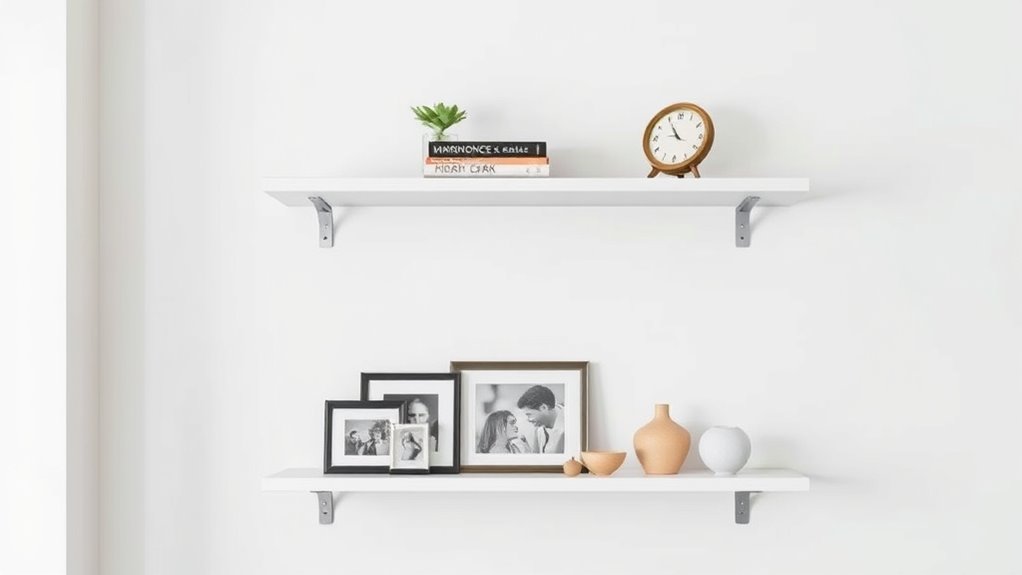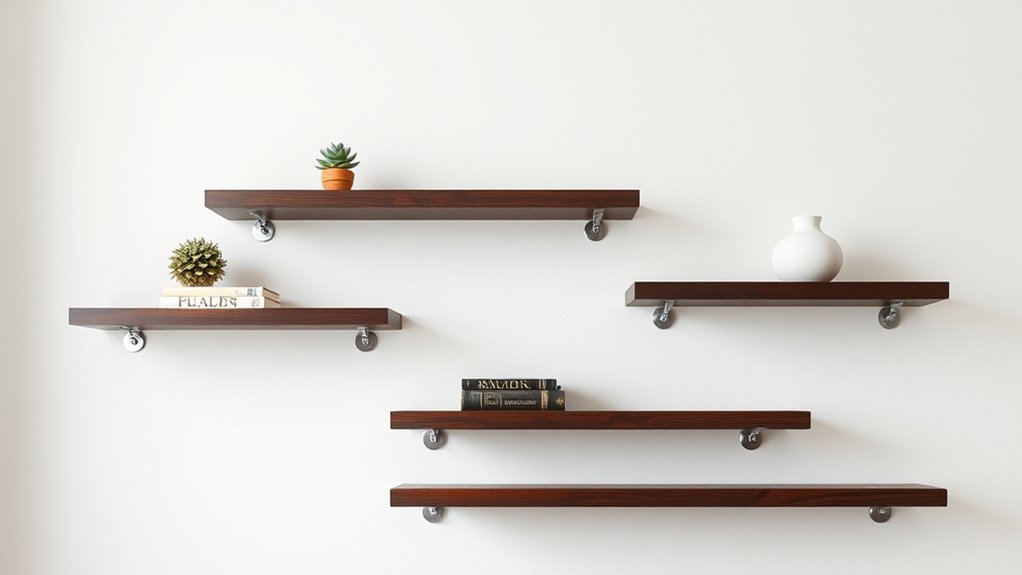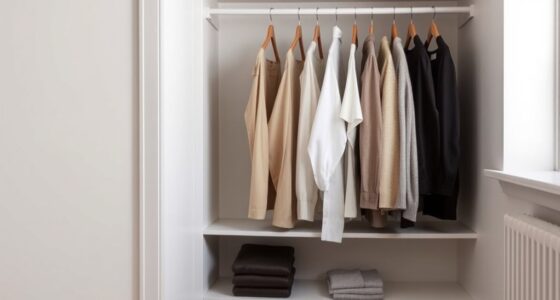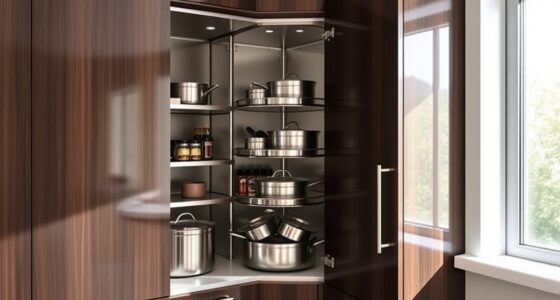Understanding the weight limits of floating shelves is key to safe and stylish decor. Most support between 10 to 50 pounds, but heavier-duty options exist. Proper support, like anchoring into wall studs, is essential—drywall alone won’t cut it for heavier objects. Using sturdy brackets and spreading weight evenly helps prevent accidents and damage. To balance function and style safely, it’s important to choose the right shelves and hardware—you’ll discover more crucial tips ahead.
Key Takeaways
- Most floating shelves support between 10 to 50 pounds, but capacity varies by design and manufacturer.
- Proper installation into wall studs is essential to maximize weight support and prevent shelf failure.
- Hardware choice, such as sturdy brackets, directly impacts the shelf’s ability to hold heavier objects safely.
- Drywall alone cannot support significant weight; always use appropriate mounting hardware for heavy items.
- Distributing weight evenly across multiple shelves or supports helps maintain safety and prolong shelf lifespan.

Floating shelves offer a sleek and modern way to maximize your space while adding a touch of style to any room. They’re perfect for displaying your favorite books, decorative items, or even small plants, all without cluttering up your surfaces. But before you start installing, it’s important to understand the weight limits of these shelves. Knowing the maximum load they can bear helps you choose the right placement and avoid accidents or damage. It’s not just about safety—it also influences your style ideas, as heavier objects might require sturdier supports, shaping how you decorate.
Floating shelves combine style and practicality; knowing their weight limits ensures safe, beautiful displays.
When considering installation tips, start by checking the shelf’s weight capacity. Most floating shelves are designed to hold anywhere from 10 to 50 pounds, but some heavy-duty options can support even more. Reading the manufacturer’s instructions carefully ensures you don’t overload the shelf. You’ll want to find wall studs for secure anchoring; drywall alone won’t support significant weight. Use a stud finder to locate the studs, and then install your brackets or mounting hardware directly into them. This provides a sturdy foundation, especially if you plan to display heavier items like books or vases.
Another vital installation tip is to level your shelves during installation. A crooked shelf not only looks bad but also unevenly distributes weight, which could cause it to fall. Use a level tool to ensure everything lines up perfectly before tightening the brackets or screws completely. If you’re aiming for a specific style idea, consider using hidden brackets or mounting hardware that creates a seamless floating appearance. This minimalist look elevates any space, making it feel more open and organized. Additionally, understanding the importance of proper installation can prevent damage and ensure your shelves hold safely over time.
In terms of style ideas, think about how your shelves can complement your existing decor. For a modern vibe, keep your display minimal with monochrome items or geometric arrangements. If you’re into a cozy, eclectic look, mix decorative objects, framed photos, and small plants. Remember, the weight limits matter here—placing a heavy sculpture or too many thick books on a single shelf could compromise its integrity. Instead, spread out your heavier objects across multiple shelves or opt for lighter decorative pieces.
Ultimately, understanding the weight limits of your floating shelves helps you decorate confidently and safely. Proper installation tips, like anchoring into studs and leveling, ensure your shelves will stay secure. And by considering style ideas that align with their weight capacity, you can create a functional yet stylish display that enhances your space without risking damage.
Frequently Asked Questions
Can Floating Shelves Hold Heavy, Unevenly Distributed Objects?
You might wonder if floating shelves can hold heavy, unevenly distributed objects. Generally, they’re great for decorative accents and seasonal decorations, but their weight limits vary. If you’re placing heavy or uneven items, make sure to verify the shelf’s weight capacity and install it properly into wall studs. This ensures your decorations stay secure and prevents damage, so you can confidently display your favorite seasonal decorations without worry.
Do Weight Limits Vary Between Different Materials Used?
You’re asking if weight limits differ between materials used for floating shelves. Well, the proof is in the pudding—material differences greatly impact weight capacity. Wood, metal, and glass each have their strengths and weaknesses, affecting how much they can hold. So, don’t assume all shelves are created equal; always check the specific weight limits for the material you choose to avoid surprises.
How Often Should I Check the Brackets for Stability?
You should check the brackets for stability every few months, especially if you notice any signs of strain or movement. Follow the installation guidelines carefully to guarantee proper support, considering the material durability of your shelves. Regular inspections help prevent accidents and maintain safety. If you see loose screws or wobbling, tighten or replace brackets promptly. This routine keeps your floating shelves secure and prolongs their lifespan.
Are There Safety Concerns With Overloading Floating Shelves?
Imagine your floating shelf as a delicate tightrope walk—overloading it risks a fall. Yes, there are safety concerns when you overload floating shelves, especially if they’re decorative rather than functional. While you want to maintain aesthetic considerations, exceeding weight limits can cause instability or damage. Always respect the recommended weight capacity to keep your display safe and beautiful, avoiding the risk of accidents or damage.
Can I Increase the Weight Capacity With Additional Supports?
You can increase your floating shelves’ weight capacity by adding support reinforcement or material upgrades. Installing additional brackets or supports distributes weight more evenly, making the shelves sturdier. Upgrading to stronger materials, like thicker wood or metal supports, also helps. Just guarantee you anchor these reinforcements securely into studs or wall anchors. This way, your shelves can safely hold more without risking damage or accidents.
Conclusion
Now that you know the weight limits for floating shelves, you can confidently display your treasures without risking catastrophe. Remember, exceeding these limits isn’t just a minor mistake—it’s like inviting a skyscraper to tumble down! By understanding and respecting these boundaries, you’ll ensure your shelves stand tall and proud, turning your space into a showcase of style and safety. So, handle your floating shelves with care, and they’ll serve you flawlessly for years to come.









